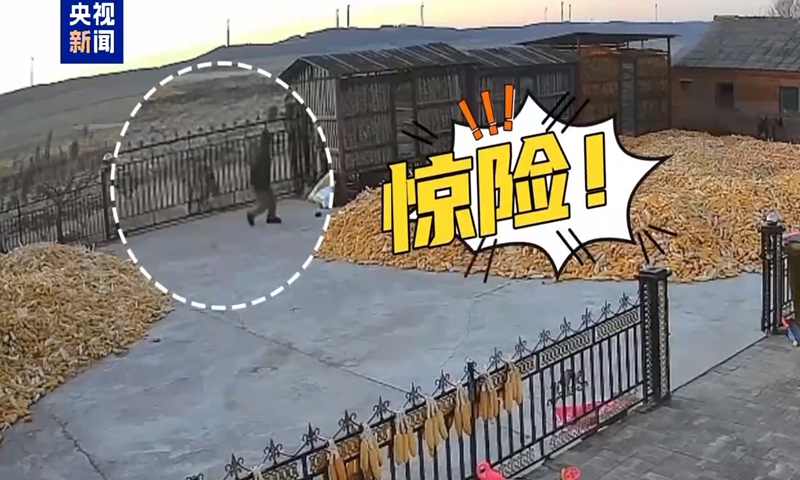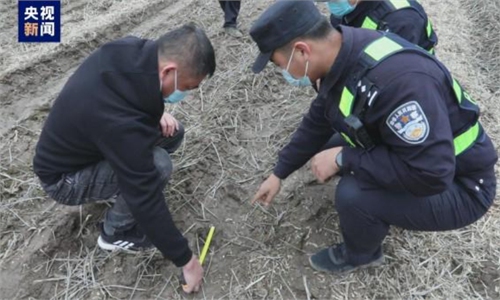Heilongjiang authorities rush to ensure peaceful co-existence of human, tigers after tiger attack incident

A video clip published by CCTV shows the tiger attempting to charge at the large iron gate of a villager's house.
Responding to the tiger attack incident in Boli county, the Forestry and Grassland Administration in Northeast China's Heilongjiang Province convened an emergency meeting on Monday to implement protective measures and ensure the safety of both the residents and tigers.
A wild tiger was spotted in a village in Heilongjiang and injured a local resident on Monday. The injured resident is currently receiving medical treatment, according to the Xinhua News Agency.
To address the incident, the Heilongjiang Forestry and Grassland Administration convened an emergency meeting on Monday to discuss protective measures aimed at ensuring the coexistence of humans and Siberian tigers. In recent years, the tiger's range has expanded significantly in Heilongjiang due to continuous improvements in the ecological environment, with tigers even appearing in non-traditional habitats. While this reflects ecological recovery, it also poses new challenges, officials at the meeting said.
"Siberian tigers are territorial animals, and winter is their mating season. During this time, adult male tigers are often more active, sometimes traveling thousands of kilometers in search of mates," Sun Quanhui, a scientist from the World Animal Protection organization, told the Global Times on Tuesday. "If their natural habitat is insufficient or food resources are scarce, wild tigers may venture into other areas to seek survival opportunities. When hungry or injured, they may take risks, such as preying on livestock or even attacking humans."
During the meeting, Hou Xumin, Director of the Provincial Forestry and Grassland Administration, emphasized the need for a multi-faceted and effective approach to ensure human-tiger safety. First, the responsibility for wildlife protection must be strictly enforced. Second, public awareness campaigns should be intensified, such as distributing flyers and setting up warning signs to educate villagers on safety precautions in areas frequented by large wild animals like tigers.
Additionally, local authorities should develop practical emergency response plans, ensuring the availability of tranquilizer guns and related equipment for rapid response in emergency situations. Targeted safety training sessions should also be organized, inviting experts to teach prevention skills and improve the emergency response capabilities of relevant personnel and villagers. Other measures proposed during the meeting included maintaining emergency resource reserves, enhancing positive media coverage, and advancing wildlife damage compensation mechanisms.
The meeting concluded by highlighting that protecting wildlife, such as Siberian tigers, is a key component of ecological civilization. This effort requires not only the government and experts but also the understanding and support of the public to foster harmony between humans and nature.
"While the number of wild Siberian tigers in China has shown a growth trend in recent years, they remain critically rare. Therefore, ordinary citizens outside tiger habitats need not be overly concerned. However, residents in areas where tigers are frequently sighted should stay vigilant, pay attention to warnings issued by authorities," Sun said.
China has successful examples of dealing with wildlife conflicts, such as the Asian elephant early warning system in Yunnan Province, which serves as a model for other regions to establish localized risk prevention systems. In recent years, Yunnan's Asian elephant population has grown steadily to over 300. Like Siberian tigers, this ecological success has also increased human-elephant activity overlap, elevating the risk of conflict, as reported by CCTV.
To address this, Yunnan has employed digital technology to support elephant conservation. Monitoring systems have accumulated vast amounts of data, images, and videos, providing a foundation for the analysis of elephant behavior and activity patterns, according to CCTV.
The choice of early warning mechanisms often depends on the species' characteristics and associated risks. "In the long term, strengthening the protection of Siberian tiger habitats remains a priority. Efforts should focus on enhancing habitat quality," Sun said.
"Animals cannot be held accountable for their actions. Achieving peaceful coexistence requires humans to minimize disturbances to wildlife and ensure sufficient living space for them."
"Siberian tigers are a key indicator species for forest ecosystem health. Protecting them not only safeguards the species itself but also helps preserve robust ecosystems and rich biodiversity, which form the foundation for human survival and development," Sun added.




